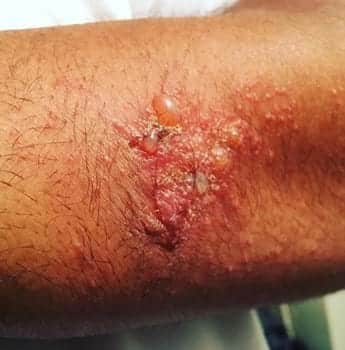
Unfortunately, there is no “cure” for poison ivy or oak rash, and the healing process can be slow and frustrating. Your skin’s reaction to poison ivy plants (or, poison oak, poison sumac) is called contact dermatitis. This condition can cause itching, redness, swelling, and even blisters. Because there isn’t a cure for poison ivy rash, it’s a matter of treating the symptoms and letting the rash run its course.
First Signs of a Rash
After exposure to the rash-causing resin (urushiol) found in poison ivy, poison oak, and poison sumac plants, a rash can start to form within 24-48 hours. For those who are extremely sensitive to the resin, a rash can start within just a few hours. Aside from the symptoms listed above, in some instances, a poison ivy sufferer will notice what appear to be small scratches at the start of a breakout. These are often confused with a simple “trail scrape” from a non-poisonous brush but are actually the start of a poison ivy rash.
How to Treat
First, and most importantly, the urushiol needs to be removed from the skin as soon as possible using a cleanser such as Tecnu. If a rash begins to develop, use an anti-itch treatment. If you experience little to no improvement after 10-14 days, contact your doctor for appropriate treatment. Cases that last 2 weeks or longer can occasionally require injectable or topical steroids prescribed by a healthcare professional.
How to Prevent
The best defense against poison ivy rash is to familiarize yourself with the plants and what they look like, that way you’ll be able to avoid contact with them. Additionally, wearing long pants and sleeves whenever possible is best, as covering exposed skin can reduce your risk of a breakout. Last, using a cleanser specifically designed to remove urushiol such as Tecnu, can help remove the resin before it bonds with the skin to form a rash; time is of the essence, wash within 8 hours for best results.




